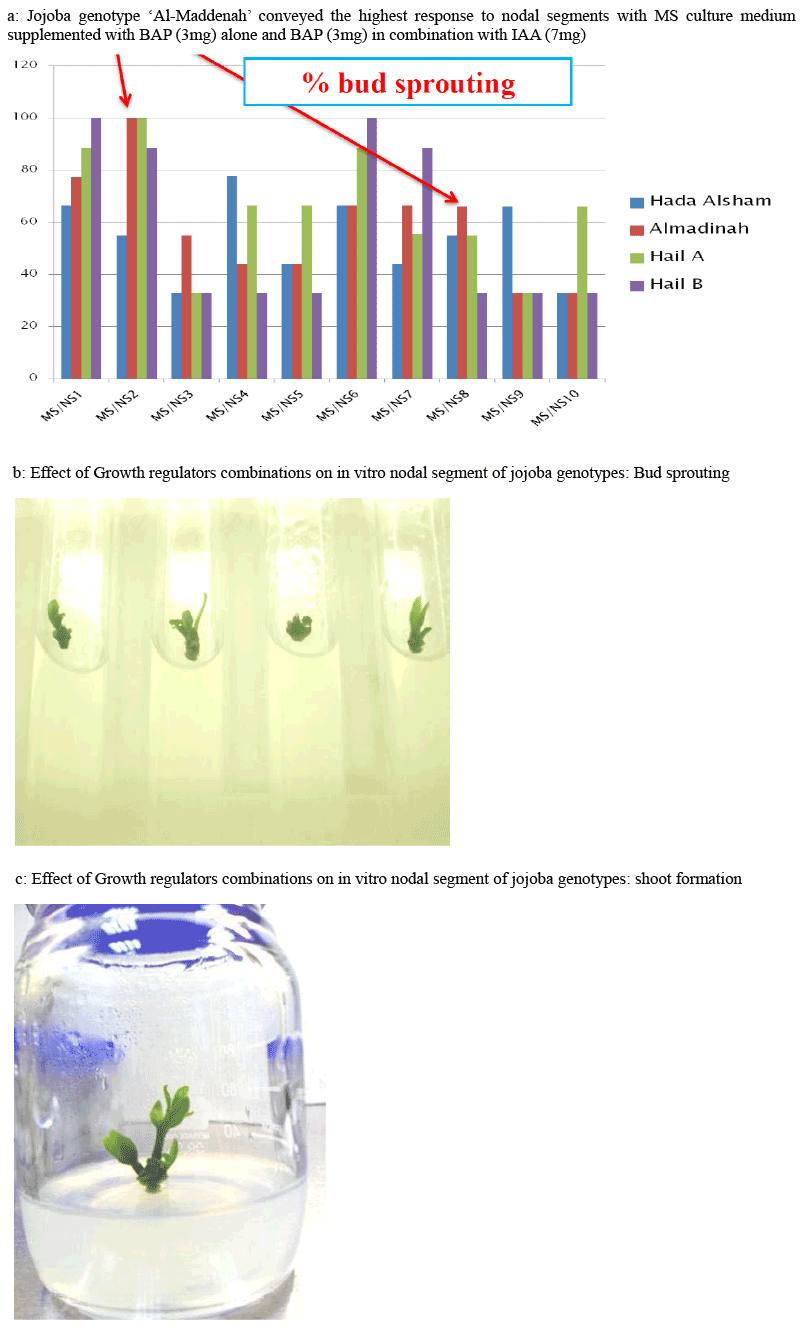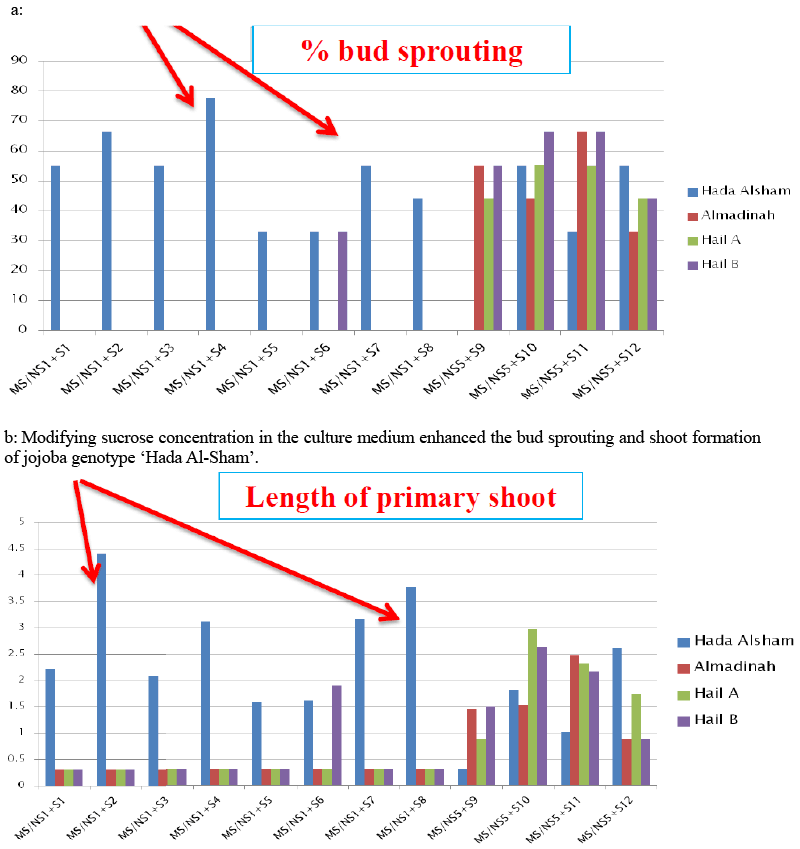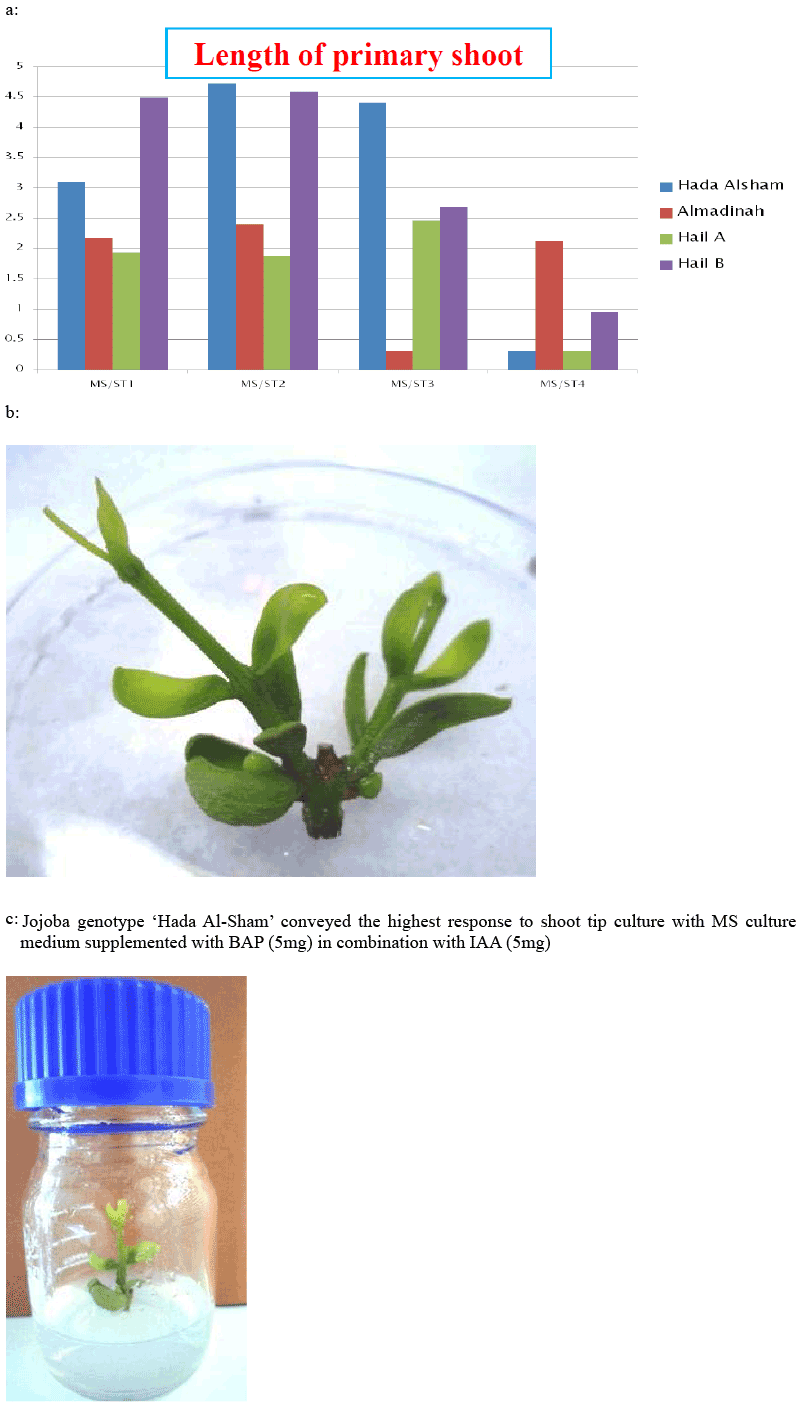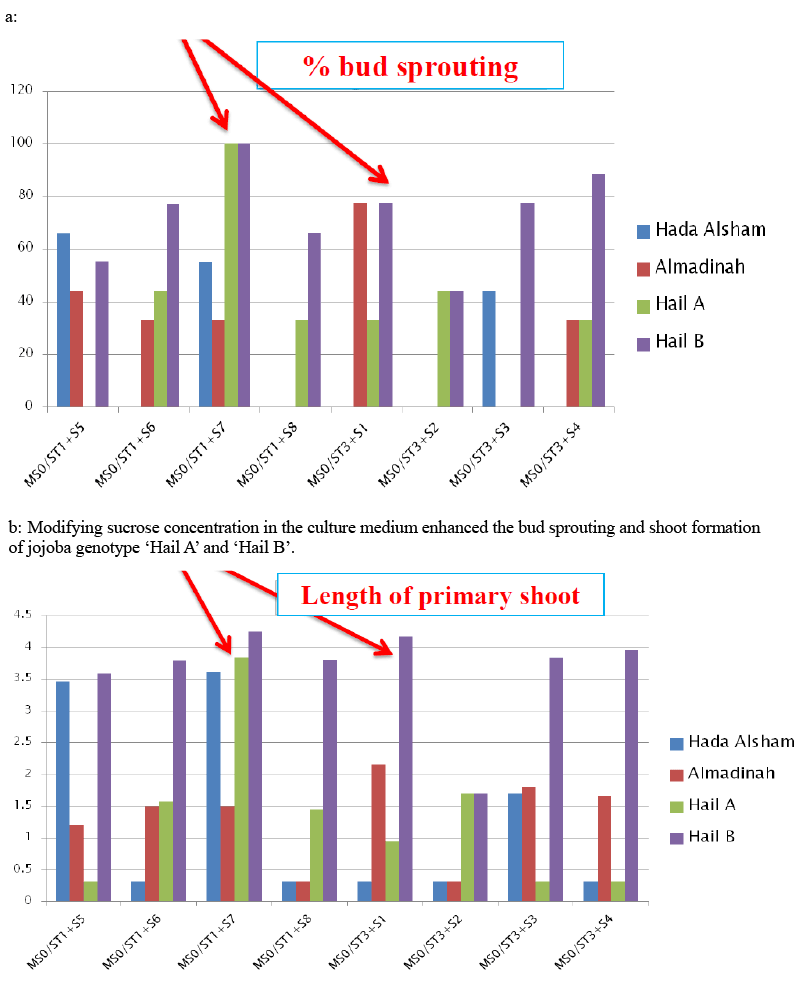Research Article Open Access
Effects of Growth Regulators and Sucrose on in vitro Nodal Segments and Shoot Tip Culture of Jojoba (Simmondsia chinensis (Link) Genotypes
| Amr SM Mohamed*, Magdi AA Mousa and Ahmed AS Bakhashwain | |
| Department of Arid land Agriculture, Faculty of Meteorology, Environment and Arid land Agriculture, King Abdulaziz University, Saudi Arabia | |
| Corresponding Author : | Amr SM Mohamed Department of Arid land Agriculture Faculty of Meteorology Environment and Arid land Agriculture King Abdulaziz University, Saudi Arabia E-mail: amrsalahw@yahoo.com |
| Received: July 20, 2013; Accepted: August 27, 2013; Published: August 29, 2013 | |
| Citation: Mohamed ASM, Mousa MAA, Bakhashwain AAS (2013) Effects of Growth Regulators and Sucrose on in vitro Nodal Segments and Shoot Tip Culture of Jojoba (Simmondsia chinensis (Link) Genotypes. J Bioremed Biodeg 4:202. doi:10.4172/2155-6199.1000202 | |
| Copyright: © 2013 Mohamed ASM, et al. This is an open-a ccess article distributed under the terms of the Creative Commons Attribution License, which permits unrestricted use, distribution, and reproduction in any medium, provided the original author and source are credited. | |
Related article at Pubmed Pubmed  Scholar Google Scholar Google |
|
Visit for more related articles at Journal of Bioremediation & Biodegradation
Abstract
The responses of four jojoba genotypes to in vitro nodal segments and shoot tip culture under different growth regulators combinations and sucrose concentrations were investigated. All experiments were laid out in Completely Randomized Blocks (CR) design using 5 replicates. The results revealed that the jojoba genotype ‘Al-Maddenah’ conveyed the highest response to nodal segments, with MS culture medium supplemented with BAP (3 mg) alone and BAP (3 mg), in combination with IAA (7 mg). Modifying sucrose concentration in the culture medium (20 g, 40 g, 50 g and 60 g) enhanced shoot formation of nodal segments of the genotype ‘Hada Al-Sham”. Concerning shoot tip culture, explants of the genotype ‘Hada Al-Sham’ were cultured on MS+BAP (5 mg)+IAA (5 mg) produced the highest percentages of bud sprouting and shoot formation. Increasing sucrose concentration from 20 g to 60 allowed the genotype ‘Hail-B’ to produced the highest percentage of bud sprouting and shoot formation.
| Keywords |
| Jojoba; Micro-propagation |
| Introduction |
| Jojoba (Simmondsia chinensis) is a perennial evergreen, dioecious and an obligated cross pollinated shrub [1]. Because of its low water requirement, root system and economical potential, jojoba was introduced to cultivation in various semi-arid and arid regions of the world. The Jojoba seeds contain about 50-55% distinctive oil, which was used commercially in the cosmetic, pharmaceutical and lubricant industries [2]. Sexual propagation of Jojoba dose not reproduce true to type plants and asexual propagation of single jojoba plant is necessary to conserve the desirable traits. Tissue culture technique suited to the multiplication of elite crops by using explants of the plant leaf, root and steam. The genotypes/clones differ in their response when cultured in vitro [3,4]. The lower concentration of BA proved more effective for many shoot parameters [5]. MS media supplemented with BA and GA3 enhanced Shoot initiation of Jojoba, while MS+IBA supported root formation [6]. Bud initiation and shoot multiplication were found to be greatest on Murashige and Skoog’s (MS) medium supplemented with BA and adenine [7]. The present study aims to investigate the responses of four jojoba genotypes to in vitro nodal segments and shoot tip culture under different growth regulators combinations and sucrose concentrations. |
| Materials and Methods |
| Plant materials |
| Four jojoba genotypes called ‘Hail A’, ‘Medina’, ‘Hail B’ and ‘Hada Al-sham’, and cultivated in the western regions of Saudi Arabia [8] were used. The 1-2 cm nodal segments were prepared from the one year established branches on the 5 years old jojoba plants (Figure 1). The actively growing shoot tips (0.5-1 cm), with both apical and auxiliary shoot buds were prepared from the newly performed branches on the jojoba plants (Figure 1). |
| Sterilization protocol |
| The explants were subjected to a sterilization protocol as following: a) thoroughly washed in running tap water for 30 min, b) dipped in 98% ethanol for seconds, c) then 10% Clorox (v/v) solution+2 drops of Tween-20 for 15 min, d) followed by four washings with sterile distilled water, each for 5 min, and e) for nodal segments the explants were dipped in 0.1% mercuric chloride (w/v) solution for 15 min, and subsequently washed 4 times in sterile distilled water each for 5 min. The sterilization steps from b to e were conducted in a laminar air flow hood. |
| Culture medium and plant growth regulators |
| Four experiments were conducted as followed: experiment (A) was designed to study the effects of plant growth regulators on nodal segments, experiment (B) was conducted to study the effects of sucrose concentrations on nodal segments, experiment (C) was carried out to study the effects of plant growth regulators on shoot tips of jojoba genotypes, and experiment (D) was conducted to study the effects of sucrose on shoot tip culture. MS medium [9] containing 30 g/l sucrose, 8 g/l agar was used. The media was supplemented with BAP alone and BAP in combinations with NAA and IAA. Four sucrose concentrations of 20, 40, 50 and 60 were tested (Table 1). The pH of the media was adjusted to 5.8 prior to adding agar. The media were autoclaved at 121°C and 1.05 kg cm-2 for 15 min. The cultured tubes were incubated under 16 h light (white fluorescent light with intensity of 55 μmol m-2s- 1) and 8 h dark, and the temperature was 24 ± 1°C. A sub-culturing at 6 weeks interval was applied onto fresh medium of the same composition to preserve the cultures. |
| Assessment of genotype response to in vitro nodal segments and shoot tip culture |
| The following parameters were estimated: number of days to bud emerges, number of leafs per explants, number of nodes per shoot and length of primary shoot (cm). |
| Conclusion and Recommendations |
| The jojoba genotype ‘Al-Maddenah’ conveyed the highest response to nodal segments, with MS culture medium supplemented with BAP (3 mg) alone, and BAP (3 mg) in combination with IAA (7 mg). Genotype ‘Hada Al-Sham’ conveyed the highest response to shoot tip culture with MS+BAP (5 mg)+IAA (5 mg). Bud sprouting and shoot formation of the genotypes ‘Hada Al-Sham’ and ‘Hail-B’ were enhanced by modifying sucrose concentrations in the culture medium. Shoot elongation and multiplication and rooting experiments are required to assess the efficiency of shoot tip and nodal segments tissue culture technique for micro-propagation of jojoba genotypes (Figure 1-4). |
| Acknowledgement |
| The author acknowledge with thanks the Deanship of High Graduate Studies (DGS), King Abd-ulaziz University, Jeddah. The author expresses his thanks to Dr. Ahmed AS Bakhashwain and Dr. Magdi AA Mousa for their valuable supervision and advices. |
References
|
Tables and Figures at a glance
| Table 1 |
Figures at a glance
 |
 |
 |
 |
| Figure 1 | Figure 2 | Figure 3 | Figure 4 |
Relevant Topics
- Anaerobic Biodegradation
- Biodegradable Balloons
- Biodegradable Confetti
- Biodegradable Diapers
- Biodegradable Plastics
- Biodegradable Sunscreen
- Biodegradation
- Bioremediation Bacteria
- Bioremediation Oil Spills
- Bioremediation Plants
- Bioremediation Products
- Ex Situ Bioremediation
- Heavy Metal Bioremediation
- In Situ Bioremediation
- Mycoremediation
- Non Biodegradable
- Phytoremediation
- Sewage Water Treatment
- Soil Bioremediation
- Types of Upwelling
- Waste Degredation
- Xenobiotics
Recommended Journals
Article Tools
Article Usage
- Total views: 13916
- [From(publication date):
August-2013 - Mar 31, 2025] - Breakdown by view type
- HTML page views : 9327
- PDF downloads : 4589
